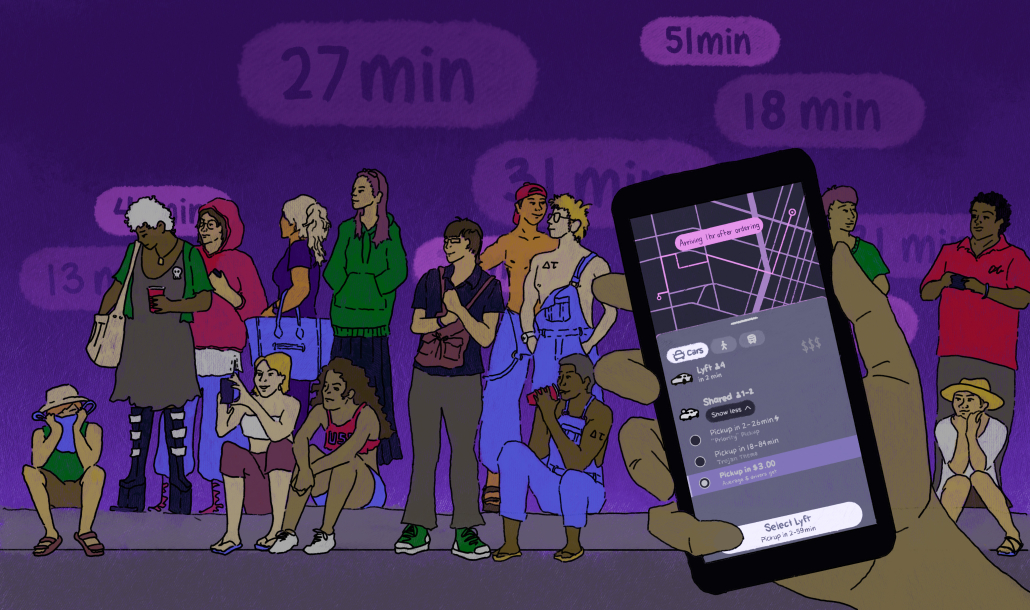Shryft sending shivers down SC’s spine

One of the biggest things that caught my attention during orientation was USC’s free Lyft program that allowed students to travel beyond the confines of campus — whether that be to get a ride home after dark or to run to USC Village or Ralphs for groceries. In such a densely-populated city with subpar public transportation, it eased both my mom’s mind and my own to have access to safe, convenient transportation as a freshman with only a skateboard to get around. Even though it was just within a one-to-two-mile radius, Fryft has saved me from having to walk home in the dark at 1 a.m. after Daily Trojan production.
However, Fryft freshman year was not as ideal or as comfortable as I thought it was. From being split up from my friends to being harassed with comments and questions from strangers, the free Lyft program followed a shared ride model that picked up other riders based on “route, destination and vehicle size,” according to a Daily Trojan news article. Nonetheless, the program still came in clutch on days where I needed to get home from the Village. It was nothing like the catastrophe that is the current Lyft model.
On Jan. 6, USC reestablished a shared Lyft model after it was initially discarded due to coronavirus concerns in Spring 2022. Despite much protesting and concerns from students, the University chose to move forward with a haphazard plan that is putting students in danger, amongst other issues. Ironically, coronavirus concerns still persist with the University continuing to send out daily coronavirus cases, a new variant popping up and the coronavirus still being a leading cause of death, hospitalization and severe illness.
In looking at the situation blankly from the University’s perspective, it might seem like students are just complaining to complain — the “University of Spoiled Children” once again
finding inconveniences in a complimentary program. But if administration were to take a step in students’ shoes, they would find Trojans waiting up to 45 minutes for a ride and with the sun setting around 6 p.m. (the program’s start time), students are waiting in the cold darkness, often alone. Whether or not students are on campus, waiting this long to get home poses valid safety concerns that the University seems to dismiss. The program and the University have hit a new low, and bus schedules in L.A. are more consistent and reliable at this point.
One of my recent shared Lyft experiences had me in a car with two random people. It took almost 15 minutes to travel 0.8 miles (it took 10 for the driver to even pick me up).
In another instance, after waiting over 20 minutes for a one-mile ride that never got picked up, I finally bit the bullet and paid $16 for a driver, an option not all students possess.
The list of grievances surrounding the shared Lyft program has continued to grow among USC’s student body, and for good reason. Free, personal rides that would’ve normally taken two to five minutes to arrive have now been replaced by inconsistent trips with strangers that seemingly never arrive in under 30 minutes.
While USC saves money through the program, drivers are putting in more effort for less money. USC already saved money by switching from a shuttle service to a partnership with Lyft, as operational costs decreased by 40% within nine months from the start of the program. Meanwhile drivers have to navigate a new system that has them constantly picking up and dropping off riders all for a lesser wage.
Beyond inconvenience, getting into a car with strangers poses many problems. Students do not know who will enter the Lyft with them or who they find themselves riding with. An intoxicated student could be put into a car with ill-willed individuals. Someone who’s leaving or arriving at their home has inadvertently disclosed that information to the random people they’re riding with. With coronavirus protocols dissipating, masks becoming less common and the uncertainty of whether or not someone is sick, the concern of getting sick still persists, especially when you share a ride.
Students often use the program because it’s all they have. Those with disabilities may not have the resources to wait an hour, pay extra money for a private ride or travel longer distances for public transportation just to get home.
Despite the University claiming to be vehemently focused on accessibility, student well-being and campus safety, it seems we have found ourselves once again asking the University, “How much is a student’s safety worth?” Rather than cutting corners or inflating a football coach’s salary, maybe it’s time to put students first as we all know the University has more than enough funding to provide.

